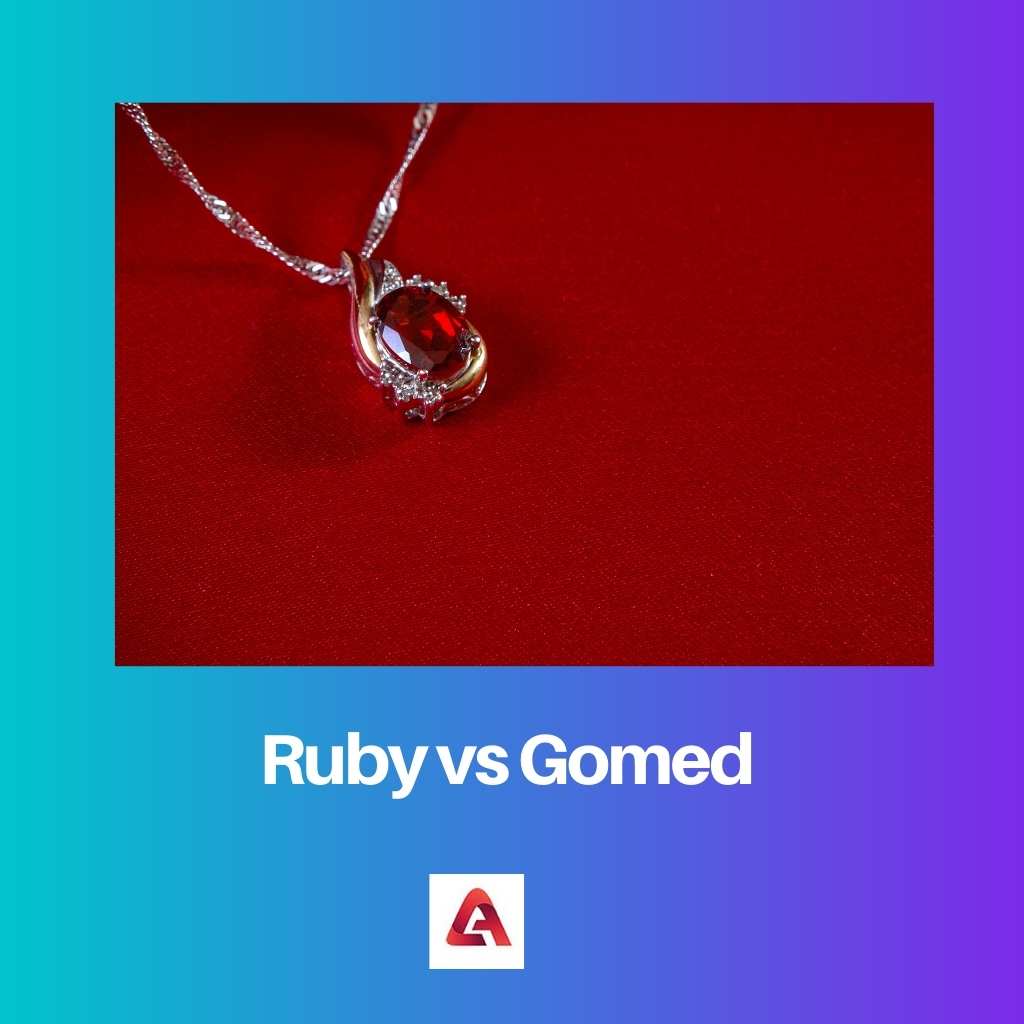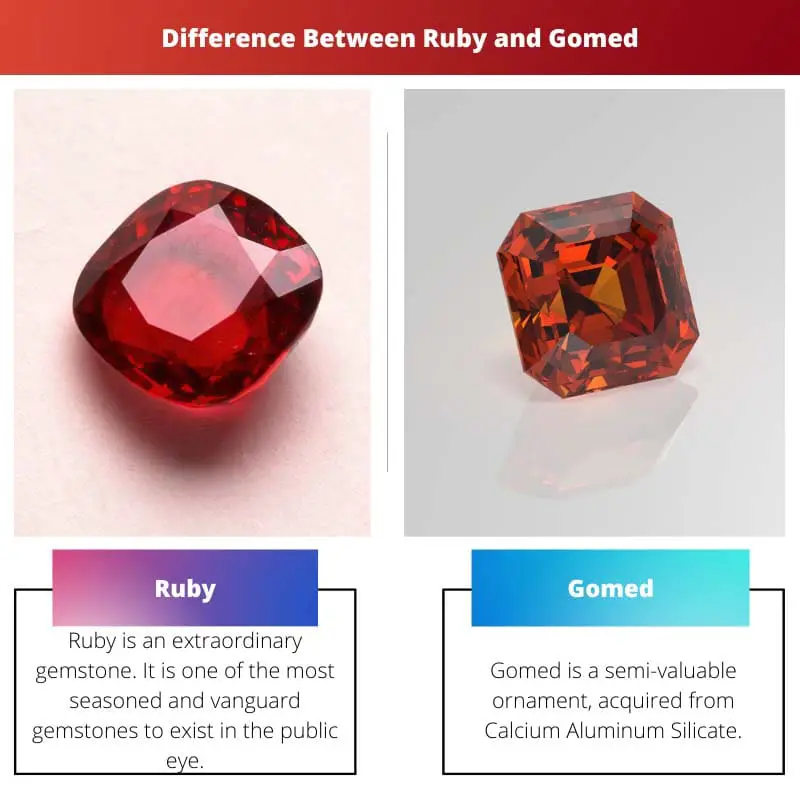Ruby and Gomed, called Hessonite Garnet, are precious stones that may appear similar in appearance and colors. But, they are highly distinctive in their properties and value.
It becomes crucial to understand the gemstones with a closer look to understand the differences in the structure and the value of the spiritual worth of the stones.
Key Takeaways
- Ruby is a red gemstone with a hardness of 9 on the Mohs scale, while Gomed is a brownish-yellow stone with a hardness of 7.5 to 8.5 on the same scale.
- Ruby is more expensive than Gomed due to its rarity and higher value, making it more suitable for high-end jewelry.
- Gomed is believed to have healing properties, especially for those suffering from anxiety and depression, whereas Ruby is believed to bring success and wealth.
Ruby vs Gomed
Ruby is a precious red gemstone jewelry known for its beauty and durability and as a symbol of love. Gomed is a brownish-yellow gemstone used in astrology believed to bring prosperity and protect against negative energies. Ruby is associated with the Sun, while Gomed is linked with the planet Rahu.

Ruby is an extraordinary gemstone. It is one of the most seasoned and vanguard gemstones to exist in the public eye. It has been protected and charmed forever and has appealing components and properties.
The term Ruby comes from the Latin word Ruber meaning Red, portraying the accessible tones for the stone.
Gomed is a semi-valuable ornament, acquired from Calcium Aluminum Silicate. It is extricated from the garnet mixture and is one of the profoundly well-known minerals on the planet.
It has been known to mankind for many years. It has a glasslike precious crystal structure with an engaging and fragile warm tone.
Comparison Table
| Parameters of Comparison | Ruby | Gomed |
|---|---|---|
| Heat Tolerance | Is prone to handling heat well and dealing with high temperatures easily. | Sensitive to heat and likely to get affected by the heat temperatures. |
| Chemical formulae | A derivation of Aluminium Oxide (Al2O3) | Calcium Aluminum Iron Silicate with formula (Ca3Al2(SiO4)3 + Fe) |
| Hardness | The adherence of Ruby is rated 9 on the scale, right after Diamond. | The adherence of Hessonite is 6.5 to 7 on the scale. |
| Effect of Light on the gemstone | Light reflects through Ruby and shines across the surface. | Gomed is not capable to reflect light efficiently but tends to appear changing colors under various glares. |
| Durability | Ruby is highly durable and lasting. | Gomed is less durable than Ruby. |
What is Ruby?
Ruby is extracted from Corundum which is the second hardest substance existing in the world after Diamond. Corundum is an amalgamation of iron, bits of Titanium, Aluminum, Iron, and small pieces of Chromium.
The Red corundum called Ruby is extracted for its delicate, cherished hue because of the presence of Chromium.
Sapphires are also derived from Corundum, but a significant red hue is called Ruby, whereas gems lighter than the deeper red color are represented as Pink Sapphire.
Ruby has a shortwave or a longwave of ultraviolet lumination showcasing its Florence.
Ruby is said to have a Star Effect because of the hexagonal shape precisely arranged matrix. Due to the hard, complex structure of Corundum, it has no cleavage and no discretion and requires minimal safety measures, and is efficient to maintain.
Ruby depicts energy, courage, durability, intelligence, and luminosity. It is prestigious to yield esteem, power, stature, to the person wearing it and poses protection with its specialized peculiarities.
It prevents any harm to the wearer. It offers tranquility, peace of mind composure to the person.
People wanting to gain mental parity, skills, bureaucratic control, and reduce anxiety and stress, are likely to wear Ruby for its exclusive characters.

What is Gomed?
Gomed was popularized in the 1960s to 70s. It is a variant of grossular garnet. Gomed is a generalized term in India for Hessonites.
The Hessonites go through perpetual tension and depict the Anomalous double refraction (ADR).
They may contain inclusion visible to people but it is not alarming when the effect does not hamper the structural integrity.
Hessonites appear to have a disrupted water illusion or appear to have a roiled reflex called the ‘Whisky in water’ effect.
Some stones may appear more opaque than others. Some of the popularized specimens of Hessonite are found in the Navratana rings.
Hessonite should be purchased with caution as it can be achieved from synthetic materials like synthetic quartz, plastic, and dyed glass.
They are sporadically refined to clear the fracture stuffing, enhance the low-category of stone cutting, and stabilize the fractured gemstone.
The gem is favored for its charismatic properties and almighty to overcome the malicious effects of Rahu. Rahu is the epitome of confusion, obsession, and dissatisfaction.
Hessonite is helpful for people deprived of the ability to make sound decision-making and daydreams. It is crucial for people who are angry inside and out and frustrated over small matters.
Main Differences Between Ruby and Gomed
- Ruby is one of the rarest ornaments in the world and while Gomed is not among the abundantly found gemstones, it is more accessible than ruby.
- The highest quality of Ruby is found in Myanmar and cherished for its greatest luster, clear appearance, and bright red color. The highest quality of Gomed is found in Sri Lanka.
- Ruby has a fine vibrant red to purplish tones. The finest quality of ruby has bright red tones. Gomed, on the other hand, has brown-yellow-marron tones ranging between lighten to darken hues.
- Ruby gemstone is found in Myanmar, Mogok, Mong Hsu, Sri Lanka, Thailand, Cambodia, and Nanyazeik. Gomed is found in Sri Lanka, Tanzania, Afghanistan, Brazil, Pakistan, India, and Canada.
- Ruby is highly lustrous, depicting its fluorescence between adamantine and vitreous. Gomed is lustrous as well and its fluorescence is described between resinous and vitreous.

- https://www.niscair.res.in/includes/images/wealthofindia/Diamond-Folder.pdf
- https://www.ncbi.nlm.nih.gov/pmc/articles/pmc3331284/
